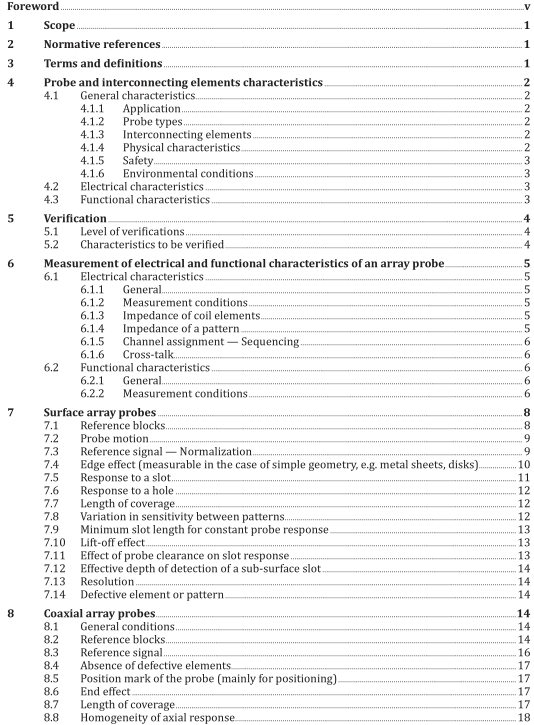ISO 20339 pdf download

ISO 20339 pdf download Non-destructive testing — Equipment for eddy current examination — Array probe characteristics and verification
6 Measurement of electrical and functional characteristics of an array probe6.1 Electrical characteristics
6.1.1 General
The electrical characteristics alone do not define the probe characteristics in its application.
The methods and measuring instruments given below are for guidance; other equivalent methodsand instrumentation can be used. When characteristics are measured using modelling, this shall beclearly stated.
6.1.2 Measurement conditions
Array probes (surface probes and coaxial probes) are in most cases specific to one application.
They are delivered with a cable, the design of which depends on the number of elements and whichcannot be removed for measurements.The characteristics of the cable are generally proprietaryinformation.
The manufacturer provides a cable, the length of which is compatible in terms of resonance andattenuation with the future use of the probe as described by the customer.
The following measurements are only applicable to elements consisting of coils.
In the case where receiving elements are not coils, specific measurements shall be defined.
The measurements are made at the probe connector which is at one end of the connecting cable,without the use of interconnecting elements of the inspection system. The probe is placed in air andaway from any conductive or magnetic material.These measurements are only possible if no electroniccomponents (such as amplifiers, multiplexers, etc.) are active in the probe.
The measurements are made for each element of the probe accessible at the probe connector.The otherelements are left open circuit.
When the probe is designed for use under particular conditions, e.g.temperature or pressure, then anyadditional measurements that are required shall be specified in the application document.
6.1.3 Impedance of coil elements
The impedance of all coil elements shall be measured using an impedance meter or impedance analyseras long as the measurement is not prevented by built-in amplifiers. The measured impedance can begiven as the values of an equivalent circuit (resistance, inductance and capacitance) or as curve vs.frequency ( Bode plot or Nyquist plot).
6.1.4Impedance of a pattern
This measurement is not normally performed by the user as it is not possible once the probe isassembled.lt is the manufacturer’s responsibility.
-lmpedance mode
Measure the complex impedance at the central frequencySeparate transmit receive
Feed a voltage with the central frequency at the input of the transmitting element and measure thevoltage at the output
Repeat the measurements on each pattern.
Verify the homogeneity of the results.
In case of significant deviation (greater than 5 %), apply the adequate corrections (connections,etc.).6.1.5 Channel assignment — Sequencing
Verification of channel assignment is essential.The following operating procedure is for guidance.Measurements are carried out at the central frequency.
Produce a C-scan type cartography of a defect at angle with the direction of scanning: a slot at 45°(Block A1) for a surface probe, a helix on a tube wall (Block B2) for coaxial probes.
The value of the angle shall be chosen in accordance with the scanning step and the dimensions of apattern.
Verify the channel assignment and the uniformity of the signals obtained on those channels.
ln the case of complex configurations, the verification procedure is left to the manufacturer’s initiative.The case of static probes in which scanning is performed electronically is not covered by thismeasurement; a case-by-case procedure shall be produced.
6.1.6 Cross-talk
Cross-talk always exists in array probes. It is actually attenuated by multiplexing non-neighbouringelements in order to achieve an acceptable signal to noise ratio.
The level of acceptable cross-talk is very much dependent on the application; therefore, acceptancecriteria cannot be given in this document.
6.2Functional characteristics
6.2.1 General
This document characterizes commonly used array probe types.Probes which are designed for special(unusual) applications shall be characterized in accordance with an application document whichfollows the methodology of this document. The characteristics described in this document can giveuseful information about such probes.
The functional characteristics are defined for two classes of array probes: surface probes andcoaxial probes.
6.2.2 Measurement conditions
6.2.2.1 General
A multi-channel eddy current instrument suitable for array probes and characterized in accordancewith IS0 15548-1 can be used, provided that it has the required accuracy.
Alternatively,sufficient instrumentation comprising a voltage/current generator,synchronousdetection amplifier and a voltmeter, oscilloscope or digitizer can be used.
When the probe does not feature a connecting cable, then the characteristics of the cable used for themeasurements shall be documented.









